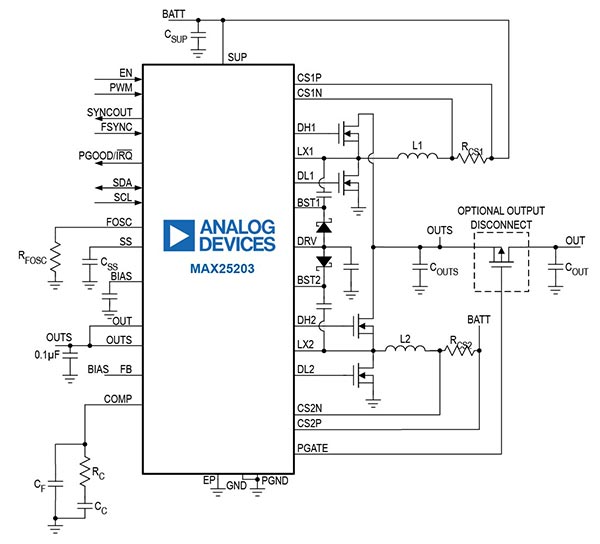 Analog Devices, Inc. (ADI) today introduced a highly efficient multi-phase synchronous boost controller that regulates high-power Class-D amplifiers in automotive infotainment systems. The MAX25203 features both programmable gate drive voltage and current limit blanking time, as well as accurate current balancing, and operates at a high switching frequency to reduce the bill of materials cost and shrink PCB space by 36 percent. The MAX25203 joins ADI’s family of automotive boost controllers that include the MAX25201 and MAX25202 single/dual boost controllers, both designed for lower power applications.
Analog Devices, Inc. (ADI) today introduced a highly efficient multi-phase synchronous boost controller that regulates high-power Class-D amplifiers in automotive infotainment systems. The MAX25203 features both programmable gate drive voltage and current limit blanking time, as well as accurate current balancing, and operates at a high switching frequency to reduce the bill of materials cost and shrink PCB space by 36 percent. The MAX25203 joins ADI’s family of automotive boost controllers that include the MAX25201 and MAX25202 single/dual boost controllers, both designed for lower power applications.
The MAX25203 controller starts with a battery input voltage from 4.5V to 42V and operates down to 1.8V after start-up. It sustains an absolute maximum output voltage of up to 70V and features a low shutdown supply current of 5µA. Useful to generate backlight and Class-D audio amplifier voltages, the MAX25203 offers I²C bus diagnostics including die temperature, phase current monitoring and optional true shutdown to improve system reliability. Output voltage is scalable via the PWM input or I²C interface and a sync-out feature supports additional phases for higher power systems.
MAX25203 Synchronous Boost Controller Key Features
- Factory programmable gate drive voltage from 5.5V to 10V increases power density by reducing MOSFET RDS(on) loss for higher efficiency and lower cost.
- Programmable current limit blanking time supports short peak current events without power supply overdesign for lower solution cost.
- ±5 percent current share accuracy from phase-to-phase reduces inductor size.
- Resistor programmable switching frequency up to 2.1 MHz improves EMI and reduces external components’ size and count.
Pricing and Availability
- The MAX25203 is available as of now in a 32-Lead TQFN-CU packaging.
- The MAX25203EVKIT Evaluation Board is also available as of now.
Additional Information
- Download data sheet, order samples and evaluation boards: https://bit.ly/MAX25203Product
- Connect with ADI digital isolation experts on EngineerZone™, an engineering community forum: https://ez.analog.com/interface-isolation


